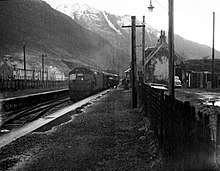Ballachulish railway station
Ballachulish was a railway station at Ballachulish on the southern shore of Loch Leven at East Laroch (south Ballachulish) in Highland.
| Ballachulish | |
|---|---|
_Station_-_geograph.org.uk_-_1746992.jpg) Ballachulish railway station in 1961 | |
| Location | |
| Place | Glencoe |
| Area | Highland |
| Coordinates | 56.6783°N 5.1308°W |
| Operations | |
| Original company | Callander and Oban Railway Ballachulish Branch |
| Pre-grouping | Callander and Oban Railway operated by Caledonian Railway |
| Post-grouping | LMS |
| Platforms | 2 |
| History | |
| 20 August 1903 | Opened as Ballachulish[1] |
| July 1905 | Renamed as Ballachulish & Glencoe[1] |
| 1908 | Renamed as Ballachulish (Glencoe) for Kinlochleven[1] |
| 25 May 1953 | Closed[1] |
| 24 August 1953 | Re-opened[1] |
| 28 March 1966 | Closed[1] |
| Disused railway stations in the United Kingdom | |
| Closed railway stations in Britain A B C D–F G H–J K–L M–O P–R S T–V W–Z | |
History

This station opened as Ballachulish on 20 August 1903[1] with two platforms. There was a goods yard on the north side of the station. Within two years it was renamed as Ballachulish & Glencoe[1] and renamed again following the opening of the 'new' road between Glencoe Village and Kinlochleven in 1908 as Ballachulish (Glencoe) for Kinlochleven.[1] Apart for a short closure in 1953, this latter name remained until closure in 1966.[1] In the railway timetables the name was shortened to simply Ballachulish with a note stating "Ballachulish is the Station for Glencoe and Kinlochleven".[2]
The station was opened by the Callander and Oban Railway, which was absorbed into the London, Midland and Scottish Railway during the Grouping of 1923. The station then passed to the Scottish Region of British Railways on nationalisation in 1948, and was closed by the British Railways Board in 1966,[1] when the Ballachulish Branch closed.
In the early 1990s the station buildings were converted into a medical centre.
Houses have been built in the station yard. The engine shed remained, being used by a local garage until 2015, when it was demolished to make way for more private housing.
| Preceding station | Historical railways | Following station | ||
|---|---|---|---|---|
| Ballachulish Ferry Line and station closed |
Callander and Oban Railway Ballachulish Branch Caledonian Railway |
Terminus | ||
Signalling
Throughout its existence, the Ballachulish Branch was worked by the electric token system. Ballachulish signal box was located west of the platforms, on the north side of the railway. It had 21 levers.
References
Notes
- Butt (1995), page 23
- Table 33, British Railways, Passenger Services Scotland summer 1962.
Sources
- Butt, R. V. J. (1995). The Directory of Railway Stations: details every public and private passenger station, halt, platform and stopping place, past and present (1st ed.). Sparkford: Patrick Stephens Ltd. ISBN 978-1-85260-508-7. OCLC 60251199.
- Fryer, Charles (1989). The Callander and Oban Railway. Oxford: Oakwood Press. ISBN 0-8536-1377-X. OCLC 21870958.
- Jowett, Alan (March 1989). Jowett's Railway Atlas of Great Britain and Ireland: From Pre-Grouping to the Present Day (1st ed.). Sparkford: Patrick Stephens Ltd. ISBN 978-1-85260-086-0. OCLC 22311137.
- Jowett, Alan (2000). Jowett's Nationalised Railway Atlas (1st ed.). Penryn, Cornwall: Atlantic Transport Publishers. ISBN 978-0-906899-99-1. OCLC 228266687.
- Ballachulish station on navigable 1954 map